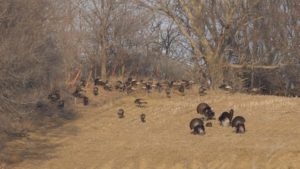The spread of the turkey population across the United States has risen to record levels. Because of this, the rise in turkey hunters has also risen. More turkeys mean more turkey hunters, which mean more pressure on the birds. So, how do you kill a turkey that doesn’t want to be killed?
So, what can we as hunters do to be successful in killing one of these call shy birds that are tougher to hunt than ever before?
The turkey calls that are on the market today are accurate and user friendly for hunters new to turkey hunting. Almost anyone can take a box call off the shelf and be efficient enough the next day to head to the turkey woods with very little practice. The problem is that turkeys have heard it before. It will be very hard to find a turkey that has not been fooled once before by just about any call on the market.
The two go-to sounds to locate or call in turkeys are yelps and the cutting of a hen. The yelp is nothing more than having a conversation with other turkeys. As a turkey hunter, chances are that the first sound you learn to make with a call is the yelp. It is the one you will use most often in the woods, and by far one of the easiest to learn. All hunters love to make the cutting sound of a hen. This is the sound that is most likely going to get a mature tom to gobble. For these two reasons these are the primary sounds in the turkey woods.
Almost always it is the hen that goes to the gobbler when he gobbles. Does it make since to try to call a gobbler to your location using hen sounds? Of course, it works sometimes, but the gobbler thinks something is amiss when a talking hen is not getting any closer.
Let’s look at it from this angle. The tom gets excited and begins to gobble in response to the excited cutting of the hen. You, the hunter gets excited because you think the tom is coming in. But, the tom is thinking the hen will be coming to him. The truth is that you and the gobbler are both at a standstill waiting for the other to approach. Cutting sounds are great to get a longbeard to gobble, but they are also the same sounds that will make a gobbler stay put while he waits for a hen to appear.
Do not get caught in a rut using just yelps and cutting. Make the gobbler believe you are more interested in food than him, or there are other turkeys with you. Do this by scratching the leaves, and calling using clucks, purrs and lazy yelps. These sounds are more likely to get a gobbler to approach your setup then cutting and yelping will.
Just like a buck grunt will cause a whitetail buck to come within easy shooting range, the sound of a strutting tom can also do the same thing to a mature gobbler. A strutting gobbler makes the spit-and-drum sound as he struts his stuff to impress other turkeys. When you hear the spit-and-drum be ready. The bird is very close.
Over the last 20 years turkey decoys have been helping turkey hunters fill their tags every year. With all the hunters in the woods using decoys, turkeys quickly become decoy shy just like geese and bucks do. Just one decoy experience that goes awry for the turkey will likely cause that turkey to have second thoughts about approaching a decoy again. When the strutting decoy hit the market a few years back they were gobbled (no pun intended) up by hunters. They were something new that turkeys had not seen before. Many turkeys have been killed because of this decoy and will be for years to come. But, they are not as effective as they were five or even seven years ago as more and more turkey hunters are using them. The new thing that has everyone’s attention is the super-life-like-full-body decoy that is so lifelike that it is scary. Sure, you can still use the foam decoys that fold up to be stuffed in your vest, but they are nowhere as effective on decoy shy gobblers. A good decoy will bring gobblers closer and hold them longer than a cartoonish looking decoy. This might not be 100-percent necessary for the shotgunner, but it definitely is for the bowhunter. Switching from a cheap, foam decoy to the realistic lifelike decoy was like switching from a black and white television set to a HD color television. There was a dramatic difference in the number of turkeys that came in to looking to fight or breed my lifelike decoys, instead of walking around my decoys, and continued to walk away.
This spring when you go to the woods looking for a mature, lovesick gobbler keep in mind that every call you sound off with, and every decoy you put in the ground is to convince a longbeard to approach. By going outside of the box compared to what other turkey hunters are doing you might see that these real-life tactics do work, and it is not always about yelping and excited cutting.
Here is a video of my wife killing her first turkey to get in the mood.









![The Best Deer Camp Chili [VIDEO] Deer Chili Ingredients, Tomatoes, Chili Spices](/wp-content/uploads/2015/10/Deer-Chili-Deer-Camp-Recipe-218x150.jpg)








![How to Call Elk Early in the Season [VIDEO]](/wp-content/uploads/2016/08/byers003-218x150.jpg)



![Idiots Disturb Hunter: How Would You Have Handled It? [VIDEO]](/wp-content/uploads/2015/10/DSC00110-e1474487693878-100x70.jpg)
![Albino Buck Shocked to Shed His Antlers [VIDEO]](/wp-content/uploads/2015/10/AlbinoDeer-100x70.jpg)